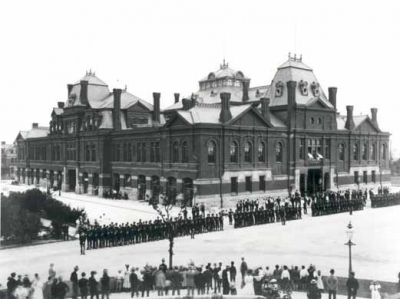The Pullman Company, founded by George Pullman, was a manufacturer of railroad cars in the mid-to-late 19th century through the first half of the 20th century, during the boom of railroads in the United States. Through rapid late-19th century development of mass production and takeover of rivals, the company developed a virtual monopoly on production and ownership of sleeper cars. During a severe economic downturn, the 1894 Pullman Strike by company workers proved a transforming moment in American labor history. At the company's peak in the early 20th century, its cars accommodated 26 million people a year, and it in effect operated "the largest hotel in the world". Its production workers initially lived in a planned worker community (or "company town") named Pullman, Chicago.Pullman developed the sleeping car, which carried his name into the 1980s. Pullman did not just manufacture the cars, it also operated them on most of the railroads in the United States, paying railroad companies to couple the cars to trains. In return, by the mid-20th century, these railroads would own Pullman outright. A labor union associated with the company, the Brotherhood of Sleeping Car Porters, founded and organized by A. Philip Randolph, was one of the most powerful African-American political entities of the 20th century. The company also built thousands of streetcars and trolley buses for use in cities. Post-WWII changes in automobile and airplane transport led to a steep decline in the company's fortunes. It collapsed in 1968, with a successor company continuing operations until 1981.
The Pullman Strike was two interrelated strikes in 1894 that shaped national labor policy in the United States during a period of deep economic depression. First came a strike by the American Railway Union (ARU) against the Pullman factory in Chicago in spring 1894. When it failed the ARU launched a national boycott against all trains that carried Pullman passenger cars. The nationwide railroad boycott that lasted from May 11 to July 20, 1894, was a turning point for US labor law. It pitted the American Railway Union (ARU) against the Pullman Company, the main railroads, the main labor unions, and the federal government of the United States under President Grover Cleveland. The strike and boycott shut down much of the nation's freight and passenger traffic west of Detroit, Michigan. The conflict began in Chicago, on May 11 when nearly 4,000 factory employees of the Pullman Company began a wildcat strike in response to recent reductions in wages. Most of the factory workers who built Pullman cars lived in the "company town" of Pullman just outside of Chicago. It was designed as a model community by its namesake founder and owner George Pullman.As the Panic of 1893 shut down much of the economy, railroads stopped purchase of new passenger cars from Pullman. When his company laid off workers and lowered wages, it did not reduce rents, and the workers called for a strike. Among the reasons for the strike were the absence of democracy within the town of Pullman and its politics, the rigid paternalistic control of the workers by the company, excessive water and gas rates, and a refusal by the company to allow workers to buy and own houses. They had not yet formed a union. Founded in 1893 by Eugene V. Debs, the ARU was an organization of railroad workers. Debs brought in ARU organizers to Pullman and signed up many of the disgruntled factory workers. When the Pullman Company refused recognition of the ARU or any negotiations, ARU called a strike against the factory, but it showed no sign of success. To win the strike, Debs decided to stop the movement of Pullman cars on railroads. The over-the-rail Pullman employees (such as conductors and porters) did not go on strike.Debs and the ARU called a massive boycott against all trains that carried a Pullman car. It affected most rail lines west of Detroit and at its peak involved some 250,000 workers in 27 states. The American Federation of Labor (AFL) opposed the boycott because the ARU was trying to take its membership. The high prestige railroad brotherhoods of Conductors and Engineers were opposed to the boycott. The Fireman brotherhood—of which Debs had been a prominent leader—was split. The General Managers' Association of the railroads coordinated the opposition.
Thirty people were killed in riots in Chicago alone. Historian David Ray Papke, building on the work of Almont Lindsey published in 1942, estimated another 40 were killed in other states. Property damage exceeded $80 million.The federal government obtained an injunction against the union, Debs, and other boycott leaders, ordering them to stop interfering with trains that carried mail cars. After the strikers refused, President Grover Cleveland ordered in the Army to stop the strikers from obstructing the trains. Violence broke out in many cities, and the strike collapsed. Defended by a team including Clarence Darrow, Debs was convicted of violating a court order and sentenced to prison; the ARU then dissolved.

1894May, 11
Pullman Strike: Four thousand Pullman Palace Car Company workers go on a wildcat strike in Illinois.
Choose Another Date
Events on 1894
- 14Apr
Kinetoscope
The first ever commercial motion picture house opened in New York City using ten Kinetoscopes, a device for peep-show viewing of films. - 11May
Pullman Palace Car Company
Pullman Strike: Four thousand Pullman Palace Car Company workers go on a wildcat strike in Illinois. - 4Jul
Sanford B. Dole
The short-lived Republic of Hawaii is proclaimed by Sanford B. Dole. - 25Aug
Bubonic plague
Kitasato Shibasaburō discovers the infectious agent of the bubonic plague and publishes his findings in The Lancet. - 1Nov
Annie Oakley
Buffalo Bill, 15 of his Indians, and Annie Oakley were filmed by Thomas Edison in his Black Maria Studio in West Orange, New Jersey.

 English
English  español
español  français
français  português
português  русский
русский  العربية
العربية  简体中文
简体中文 